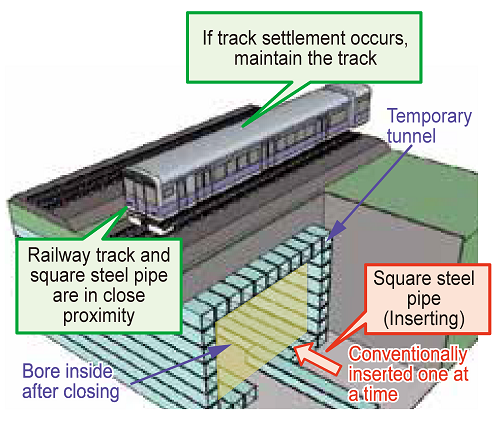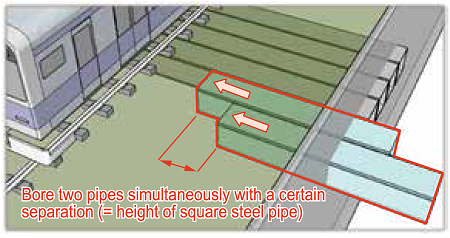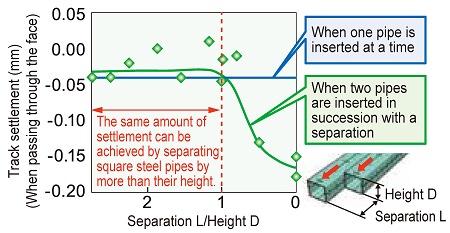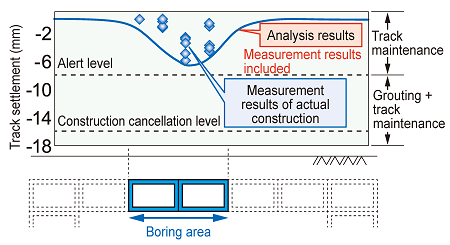13. Boring method for constructing a crossing structure under railway tracks making it possible to shorten the construction period
Construction of tunnels, including roads that cross under railway tracks, is underway to eliminate level crossings. When constructing a tunnel crossing under railway tracks, a temporary tunnel using square steel pipes is constructed in advance. With the conventional method, square steel pipes are inserted one at a time for boring to create a closed cross-section (Fig. 1), while track measurement and management, track maintenance, and grouting are carried out, so it requires a longer construction period and higher cost compared to general tunnel construction.
Therefore, for constructing a temporary tunnel, we have proposed a stepped boring method that can control the amount of track settlement at the same level as before (Fig. 2). The step-boring method is a method of boring the second square steel pipe simultaneously with a certain "separation" and a time difference from the preceding first pipe. The appropriate amount of separation was clarified by model experiment (Fig. 3). By boring two pipes at the same time, the construction speed can be almost double that of boring one pipe at a time. This can reduce the time required for boring by half and the cost of track measurement and management and track maintenance during boring by about 50%.
If the railway tracks and square steel pipes are in close proximity to each other, it will be necessary to determine whether countermeasures such as grouting to prevent settlement are necessary. In order to do this accurately, we have developed a numerical analysis method that can precisely predict the amount of track settlement (Fig. 4).
Other Contents
- 9. Restoration techniques for embankments reusing collapsed soil
- 10. Structural performance evaluation of existing bridges by acceleration monitoring
- 11. Multi-point synchronous measurement system for railway bridge vibration using a video camera
- 12. Low-cost deterioration evaluation method for the backside ground of slope protection works
- 13. Boring method for constructing a crossing structure under railway tracks making it possible to shorten the construction period
- 14. Maintenance method for prestressed concrete sleepers according to the installation environment
- 15. Low-cost ballastless tracks for existing lines and roadbed improvement method
- 16. The image analysis engine for around track to support train patrol
- 17. Insulator contamination estimation method based on public data
- 18. Degradation evaluation method for lithium-ion batteries for vehicle control circuits
- 9. Restoration techniques for embankments reusing collapsed soil
- 10. Structural performance evaluation of existing bridges by acceleration monitoring
- 11. Multi-point synchronous measurement system for railway bridge vibration using a video camera
- 12. Low-cost deterioration evaluation method for the backside ground of slope protection works
- 13. Boring method for constructing a crossing structure under railway tracks making it possible to shorten the construction period
- 14. Maintenance method for prestressed concrete sleepers according to the installation environment
- 15. Low-cost ballastless tracks for existing lines and roadbed improvement method
- 16. The image analysis engine for around track to support train patrol
- 17. Insulator contamination estimation method based on public data
- 18. Degradation evaluation method for lithium-ion batteries for vehicle control circuits




